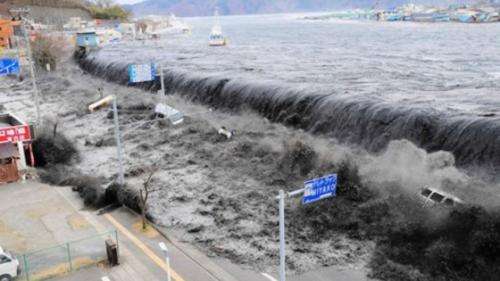Tsunamis are caused by earthquakes under the seabed. Some tsunamis--including the disaster that hit Japan last year--are unexpectedly large. Cambridge scientists suggest that their severity is caused by a release of gravitational energy as well as elastic energy.
Scientists at Cambridge University have developed a model that may show why some tsunamis—including the one that devastated Japan in March 2011ar—e so much larger than expected. The Japanese tsunami baffled the world's experts as it was far bigger than might have been anticipated from what is known about the deep sea earthquakes that create long waves out in the ocean.
In a paper published today (24 August 2012) in the journal Earth and Planetary Science Letters, Professors Dan McKenzie and James Jackson of Cambridge's Department of Earth Sciences describe for the first time the added factor that may have made this tsunami so severe: a huge collapse of soft material on the sea bed resulted in a far greater movement of water than would have been caused by the earthquake alone.
Tsunamis occur when an earthquake rapidly changes the shape of the sea floor, displacing the water above it. The earthquake itself is the abrupt rupture of a fault surface separating rocks that have steadily been bending like a loaded spring, before suddenly overcoming friction and slipping, releasing the elastic energy. In the case of the Japan earthquake, the fault is the plate boundary, allowing the Pacific sea floor to slide beneath Japan. The wave formed at the sea surface as the sea floor moves can cause untold damage when it hits shore.
"As the plates move against each other, the rocks on their boundaries slowly bend under the pressure, until they eventually crack and slide on faults. When they do, there is an upwards and outwards movement that takes just a few seconds: a movement of 10 metres is a large earthquake and out at sea this causes a tsunami," said Professor Jackson.
"But data from the Japanese earthquake show a movement of more than 60 metres. Rocks can bend—but they cannot bend to that extent and, anyway, the rocks that moved were sloppy sediments with little strength. This suggests that something else was taking place to increase the movement several fold. It was this massive movement that caused the tsunami that swamped the coast of Japan and beyond with such terrible consequences."
Important advances in technologies for monitoring movements on the sea bed, plus a huge investment by the Japanese government, mean that the world's scientific community has access to an unprecedented level of data about what happened in March 2011 some seven km under the sea and around 70 km off the coast of Japan.
By interpreting data gathered in the lead-up to and aftermath of the Japanese tsunami, as well as during the event itself, the Cambridge scientists have shown that the squeezing together of two plates in the earth's crust not only resulted in a fracture but also caused a massive collapse of the debris that had built up on the sea bed as tectonic movements scraped loose sediment into an unstable wedge.
"When the wedge of material collapsed, the leading edge split off and shot forward a bit like a pip shooting out of a giant pair of tongs. In essence, what happened was a release of both the elastic energy stored in the rocks and the gravitational energy contained in the wedge-shaped build-up of debris," said Professor Jackson.
The extra movement of the sea bed at the toe of the wedge enhanced the shape of the huge wave created at the surface of the sea, which travelled towards Japan.
The research throws a light on other unusually large tsunamis that have long puzzled scientists, including those that struck Nicaragua in 1992, Sumatra in 2004, and Java in 2006. A comparison of data from these events with that from the recent Japanese tsunami reveals that they have much in common, strongly suggesting that these disasters too occurred as a result of the release of gravitational as well as elastic energy.
"These events share a number of unusual features, including large displacements, suggesting that they resulted partly from the collapse of debris. We hope that our research represents a step forward in understanding how large tsunamis occur and in what circumstances they are likely to happen," said Professor Jackson.
Journal information: Earth and Planetary Science Letters
Provided by University of Cambridge





















